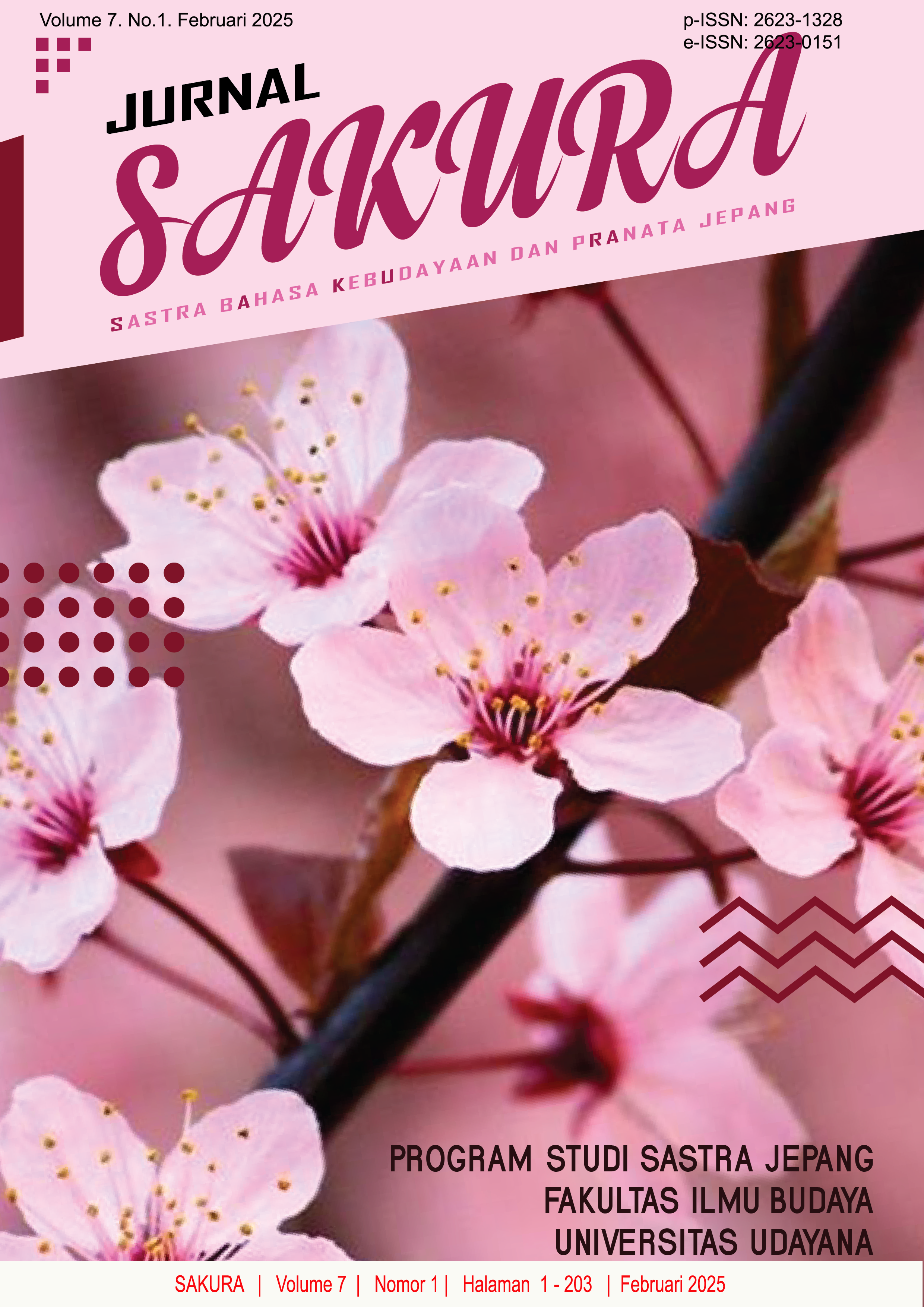Penggunaan Roujingo dalam Anime Bahasa Jepang
Abstract
This study aims to describe the different nuances produced in characters who use roujingo??? in anime and describe the differences between the use of roujingo??? in anime and reality. Japanese has a standardized language variety called hyoujungo???. Within hyoujungo???, there is another language variety called yakuwarigo??? which means role language. Kinsui (2017) divides yakuwarigo???into 6 types. The researcher is interested in examining one type of ???yakuwarigo based on the age of the language user, namely rounen??or roujingo???or the language of seniors. roujingo???is the language used by characters who are depicted with moustaches white hair and old faces. This research method is descriptive qualitative, which is research conducted to determine the value of independent variables, either one or more variables (independent) without making comparisons or connecting with other variables. The descriptive qualitative research method is used in this study to describe the existing facts of the use of roujingo in anime. The research data was taken from 8 anime published in the period 2000-2022. The data was analyzed by looking at the use of roujingo??? from anime characters with different social statuses. The conclusion of this study is that the author found two different functions of using roujingo??? . First, as a marker of parental nuance. Second, as a marker of grandeur and power, indicating high social status and power. Another finding of this study is that roujingo ??? is not used by old people suddenly. Japanese people do not change their language to that of their parents when they reach old age. Instead, the use of roujingo??? is limited to works such as anime and manga, used to portray old, regal, and powerful roles.
Downloads
References
Fachria, irhamna (2023) Analisis Ragam Bahasa Roujingo dalam Manga Chainsawman karya Fujimoto Tatsuki.Skripsi thesis. Sekolah Tinggi Bahasa Asing JIA.
Jayusman, I., & Shavab, O. K. (2020). Studi Deskriptif Kuantitatif Tentang Aktivitas Belajar Mahasiswa Dengan Menggunakan Media Pembelajaran Edmodo Dalam Pembelajaran Sejarah. In Halaman | 13 Jurnal Artefak (Vol. 7, Issue 1). https://jurnal.unigal.ac.id/index.php/artefak
Kartikasari, R. D. (2016). Ragam Bahasa Pedagang Kaki Lima Di Terminal Purabaya Surabaya: Kajian Sosiolinguistik. Jurnal Pendidikan Bahasa dan Sastra Indonesia Metalingua. Universitas Trunojoyo Madura. DOI: https://doi.org/10.21107/metalingua.v3i2.7039
Kinsui, S. (2017). Title Virtual Japanese : Enigmas of Role Language. https://hdl.handle.net/11094/67215
Kinsui, S., & Yamakido, H. (2015). Role Language and Character Language. Acta Linguistica Asiatica, 5(2), 29–42. https://doi.org/10.4312/ala.5.2.29-42
Latifah, L. (2017). Variasi Bahasa Dilihat Dari Segi Pemakai Pada Ranah Sosial Masyarakat Tutur Perbatasan Jawa Tengah-Jawa Barat Di Majenang Kabupaten Cilacap. Tesis. Universitas Sebelas Maret.
Maulina, & Nurjaleka, Karakteristik Yakuwarigo dalam Tokoh Anime Gintama Kiryoku, vol. 4, no. 1, pp. 48-61, Jun. 2020. https://doi.org/10.14710/kiryoku.v4i1.44-57
Malabar, S. (2015). Sosiolinguistik (M. Mirnawati, Ed.). Ideas Publishing.
Paul, A. J. (2008). Analisis Stereotip Karakter Berdialek Osaka Dalam Anime.
Perdana, D. D. (2014). Stereotip Gender dalam Film Anna Karenina.
Rahardjo, Hardianto.2016. Penggunaan Yakuwarigo (Role Language) Bahasa Jepang dalam Dialog Manga. Jurnal Pendidikan Bahasa Jepang ASPBJI Korwil Jabar, Vol.10 No.2, 100-108.
Raco, J. R. (n.d.). Metode Penelitian Kualitatif Jenis, Karakteristik dan Keunggulannya. PT Grasindo.
Ramlan. (2018). Language Standardization In General Point Of View. www.birci-journal.com
Subadi, T. (2008). Sosiologi. BP-FKIP UMS.
Supriyadi. (2016). Community Of Practitioners : Solusi Alternatif Berbagi. Lentera Pustaka, 2(2), 83–93.













